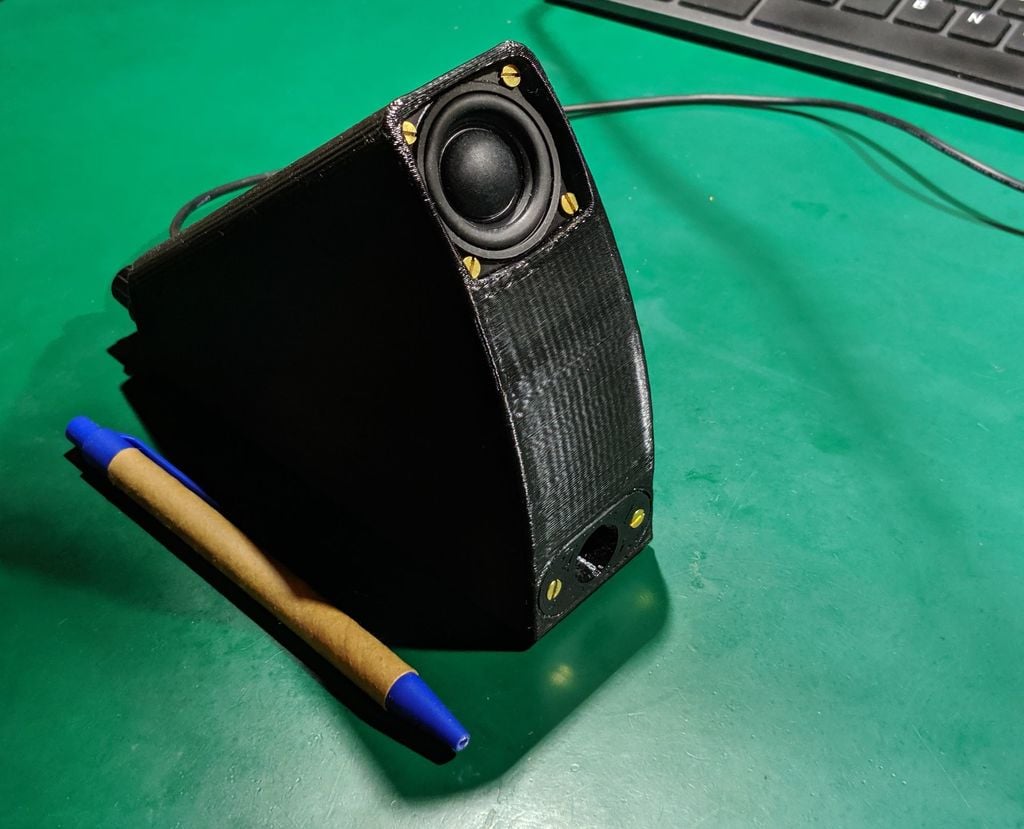
Tiny computer speakers basing on Visaton BF37
thingiverse
Hello, Here are the computer speakers based on Visaton BF37 tiny transducers. My primary goal was to challenge the rules of physics and create as small speakers as possible that deliver a lot of bass :) And here is what I've achieved. To calculate the size of the cabinet, I used WinISD (free software for speaker cabinet calculations) fed with the set of Thielle-Small parameters provided by Visaton. The ideal volume is 0.38 L while the length of the bass-reflex pipe is 10 cm for its internal diameter of 12 mm. Here you can listen to them: https://www.youtube.com/watch?v=MFXrRalvIiA Besides 3D printed cabinets and speakers, I've used: - 21 x M2.5 screws, - 2 x audio cables with jack plugs on one side. Could be a jack-jack cable split into 2 halves. - 1 x tiny 3W 5V D-class stereo amplifier, - 1 x jack socket (to detach the passive speaker). - 1 x the TP4056 li-ion charger module, where I just use the micro-USB socket. You can also use the rest of the charger if you want to utilize the internal li-ion battery and have the possibility of charging it from USB. The cabinet dimensions are: W = 42 mm, H = 122 mm, D = 144 mm. The interior is filled with cotton wool. If you want to optimize the volume further, you may redesign the shape of the cabinets to make them more prism-like (or rectangular, if you wish). The low frequency response is impressive for such small speakers. If WinISD doesn't cheat, the low cut-off frequency should be as low as 80 Hz (I haven't confirmed it because I don't own a suitable microphone). I'm afraid it seems a bit optimistic, but anyway - give them a try and you'll judge yourself. Additional notes: - Supports are not needed, but as the walls are tilted, you've got to take care of proper cooling - which seems easy with PETG. You may use PLA if you wish. - The bass reflex-pipe length is 11 cm. According to WinISD calculations, it should be 10 cm, however, as the STL model is a bit longer, so you can tune the low frequency response by adapting the length a bit. In my speakers' case, a 10 cm long pipe works well. - Take care of speaker polarity. - I forgot to design a potentiometer knob, that's why I've used a stock one. It will be updated soon. - The charger costs less than $0.5 and the amplifier costs less than $1. - The speakers are a bit more expensive around $10 each. - Active speakers consist of an amplifier and micro-USB socket, while passive ones don't have any active components. Therefore, the back covers differ for active and passive speakers. - You may use thinner print layers for nicer appearance. I wasn't patient enough to do so. - A hand grinder (or at least a sharp knife) will be necessary for adapting parts to make them fitting together. Particulary, it will be necessary to remove part of the screw fastening on the backside of the main part. They slightly collide with the amplifier PCB and the jack socket. However I've done it that way to avoid using supports. - The enclosures have to be assembled tightly because sealing is essential for the bass. Leakages reduce low frequency response a lot. I encountered this after the first assembly when I didn't use screws to attach loudspeakers. Tiny holes - big negative impact on sound quality. - I plan to design speaker grills (together with potentiometer knob), so stay tuned.
With this file you will be able to print Tiny computer speakers basing on Visaton BF37 with your 3D printer. Click on the button and save the file on your computer to work, edit or customize your design. You can also find more 3D designs for printers on Tiny computer speakers basing on Visaton BF37.
